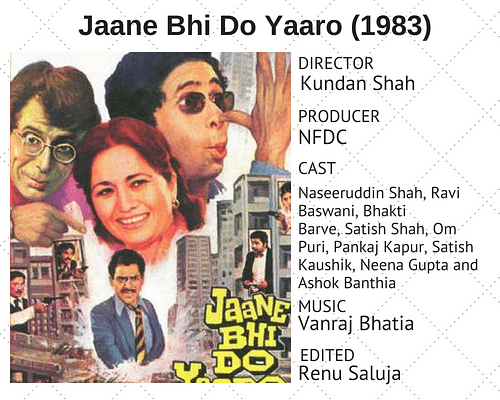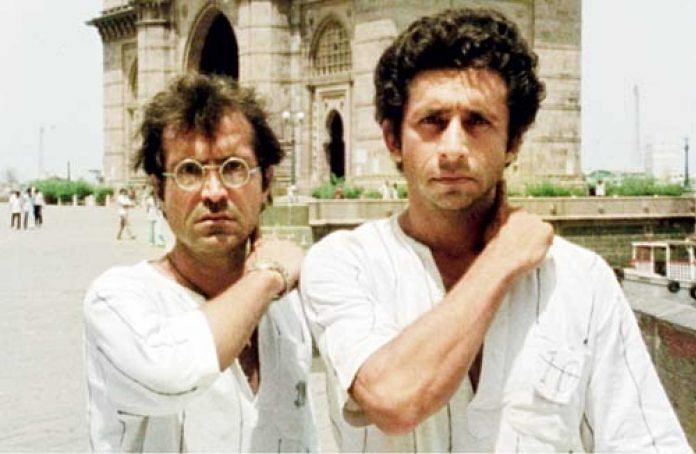The tragedy of India is that almost four decades later, we are still living inside that last iconic shot of the film.
Prime Minister Narendra Modi made an astounding comment recently at an event to mark the World Biofuel Day. He talked about the story of a ‘chaiwala’ (tea-seller) who uses biogas from sewage as fuel. It didn’t take too long for the internet to burst out laughing. The incident reminded many Indians of a scene from the iconic but small-budget 1983 film called Jaane Bhi Do Yaaro.
“D’Mello Sahab kehte the ki agar kisi desh ki unnati ki pehchaan agar kisi cheez se hoti hai to wo hai gutter. (Mr D’Mello used to say that the progress of a country is measured through its gutters.)”
 This line, attributed to the funniest ‘dead body’ in Indian cinema history, was an over-the-top satirical remark on a corrupt municipal and political administration of a metropolis that abandons its responsibility. Who knew that the over-the-top dialogue in the cult film will become part of the political discourse of the country a few generations later.
This line, attributed to the funniest ‘dead body’ in Indian cinema history, was an over-the-top satirical remark on a corrupt municipal and political administration of a metropolis that abandons its responsibility. Who knew that the over-the-top dialogue in the cult film will become part of the political discourse of the country a few generations later.
Jaane Bhi Do Yaaro presented an enduring image of India as a cocktail of corruption, cynicism and comedy. It has become a touchstone not only for anyone who questions power in India but also for those who give up questioning.
Also read: Amar Akbar Anthony is the perfect thematic prequel to Mulk
In the 35 years since its release, director Kundan Shah’s absurdist comedy has created a sub-genre of its own spawning several lesser imitations, books, and researches. Its biting political commentary marked by a sharp but accessible humour remains a pinnacle that is yet to be surmounted by anyone else. Shah himself tried and failed.
In 1983, Shah assembled a bunch of Film and Television Institute of India (FTII) graduates, almost all Left-leaning, to make a political satire that was funded by the state producer National Film Development Corporation. The assembly list remains illustrious.
Written by Shah and then filmmakers-in-waiting Sudhir Mishra, Ranjit Kapur, and Satish Kaushik, the film starred arthouse circuit favourites Naseeruddin Shah, Pankaj Kapur, Neena Gupta, Ravi Baswani and Om Puri.
The film is centred on two out-of-work photographers, Sudhir and Vinod (named as an in-joke about the two crew members), who chance upon a business and political conspiracy featuring a nexus between politicians, businessmen and the media. The film’s plot about networks of power makes the Radia tape scandal look like a teddy bear’s picnic. The film’s cynicism cuts through to date.
Also read: Jeevan Mrityu is the movie to see as India amends corruption act to protect civil servants
Its take on corruption in India was so astute that regardless of who makes a film on the theme, Jaane Bhi Do Yaaro will remain an inspiration. Scene after scene, character after character, and you can pick any, will tell you the story of India’s challenges.
From the corrupt municipal commissioner D’Mello (Satish Shah) to the ruthless builder Tarneja (Pankaj Kapur) to the bumbling photographers or the sly journalist Shobha Sen (Bhakti Barve), the deliberately loony characters have more to offer than just sermons.
And we haven’t even counted the only sharaabi character from the ‘80s that you need to remember: Ahuja (Om Puri).
Few films find such resonance that individual sequences are remembered on their own. But Jaane Bhi Do Yaaro never runs out of hilarious gags. So much so that the film’s most remembered ‘Mahabharata scene’ has now acquired a life of its own.
Shah, who assembled all his loonies in one scene, had a male corpse to play Draupadi in the epic’s ‘vastra haran’ scene. Nothing in words can match the inspired lunacy on screen. The fifteen-minute long sequence was described as the “ultimate payoff, a cultural touchstone for our generation” by film writer Jai Arjun Singh in his book Jaane Bhi Do Yaaro: Seriously Funny Since 1983. It ends with Mughal-era Salim and Anarkali, by the way.
Also read: Try watching ‘Satyakam’ in the age of post-truth, fake news and incorruptible leaders
Stories abound how the close-knit group worked around severe budget limitations (One of the unit managers was filmmaker Vidhu Vinod Chopra who had not yet achieved limelight despite having been to the Oscars in 1979). Naseeruddin Shah, has, in recent years said it was a painful experience to shoot the film, the result of which was too staggering to believe for him.
Another crew member, who later became a legend unto herself, was editor Renu Saluja. In her tour de force career, Saluja worked with the most prominent filmmakers who were bursting at the seams of mainstream Hindi films and she left an indelible mark on all of them. While editing Jaane Bhi Do Yaaro, Shah faced a lot of harrowing issues due to his budget limitations. Saluja found a way around them all. Shah later said that he completely left the film to her and that it was her baby.
Over the hundred year history of Hindi films, a lot of films have found a permanent place in the hearts of the people. But few have been able to transcend their time the way Jaane Bhi Do Yaaro did.
The film was (aptly) described as a farce on release. Despite its grim subject and dark undertones, its lunacy, and more importantly, its representation of the Indian reality, is admirable. Increasingly, one finds that by perhaps just sheer accident, Shah may have accurately predicted all that was to come (like another satire Phir Bhi Dil Hai Hindustani). And scarily, there may be more to come.
The film, keeping with its cynical view of India, ended with the two innocent photographers gesturing to the camera, in prison clothes, the ‘hanged’ sign. All this while ‘Hum Honge Kamyaab’ plays in the background.
The tragedy of India is that almost four decades later we are still living inside that last shot.



